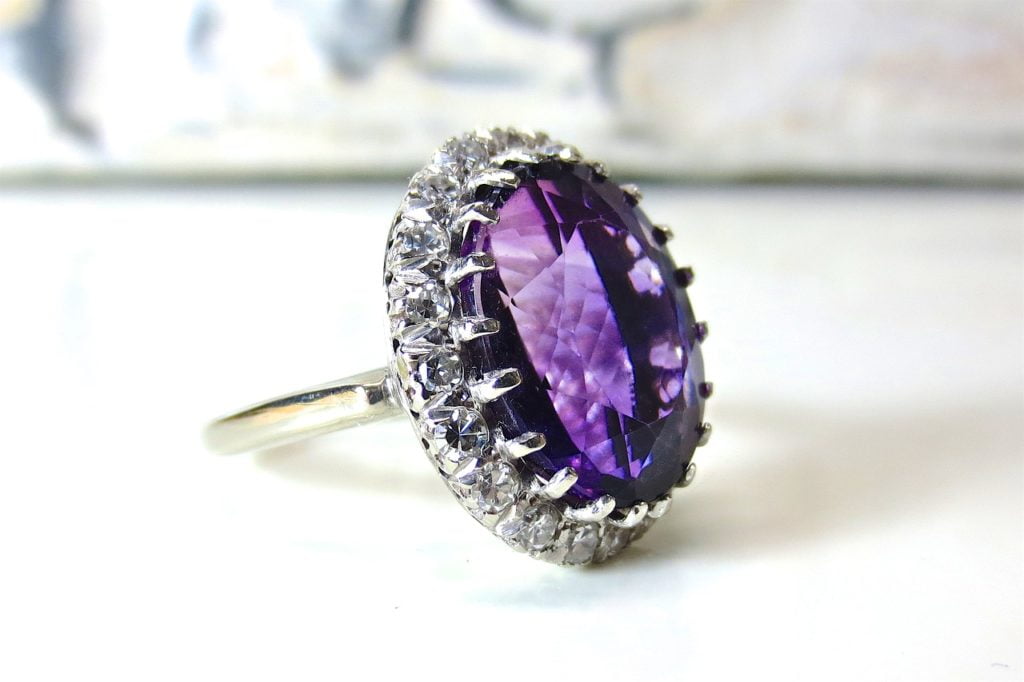February Birthstone – AMETHYST
Amethyst was once ranked highly by royalties since the days of Alexander the Great. He is very much responsible for influencing the Greek culture of jewellery and amethyst was among the most used gemstone. The reason for it is because ancient Greeks believe amethyst is associated with the god of wine and by wearing it will cure intoxication and prevent overindulgence.
Fine amethyst was thought to be as rare and valuable as the revered big 4 of diamond, ruby, emerald, and sapphire due to the scarcity of amethyst sources. Back then fine amethysts were usually reserved for royalties, it was until the discovery of huge amethyst deposits in South America in the 1800s made it available abundantly for everyone and thus dropping of its value and rarity.
This attractive purple gemstone was known as the stone of royalty, of kings and queens. Significant leaders of old kingdoms such as Rome, England, and France bore jewels containing amethyst as the centerpiece. None more so than the British monarchy who cherish amethyst so much that they have an entire jewellery collection of amethyst, known as The Kent Amethyst Demi-Parure. The entire collection consists of: a necklace, a pair of hair combs, a pair of earrings, and three brooches. Its first owner was the mother of Queen Victoria, who is the great-great-great grandmother of the current queen of the United Kingdom Queen Elizabeth II.
Above: The Queen Elizabeth II of United Kingdom. Photo credit: Tim Graham, Getty Images
Amethyst is a variety of the quartz family. The abundance of quartz meant its been found almost everywhere on Earth under different types of rocks. Quartz comes in many colours too, colourless as rock crystal quartz, brown as smoky quartz, pink as rose quartz, yellow as citrine, and the most popular of the family is the purple amethyst. In the current market, the world’s most important source of amethyst deposits are Brazil and Uruguay. The uncover of amethyst crystals both locations can go by the tons in huge deposits. Other sources include the Four Peaks Mine in Arizona USA, Madagascar, Namibia, and Sri Lanka just to name a few.
The purple hue of amethyst varies in degrees of tone and saturation, and more often contains colour zoning within the stone. Colour zonings are obvious growth marks that reflect the crystal’s trigonal geometry, usually with alternating colour intensity. So the quality of an amethyst can also be determined from the uniformity of its colour besides the tone and saturation of the hue.
Recently, gem cutters find the appeal of fancy cutting amethyst due to its high transparency and availability of large crystal sizes. Large crystals are usually found along the fractures and cavities of quartzite. Unique faceting techniques often produce some of the most stunning appearance and display, those intricate cutting styles are called fantasy cut. These uncommon skills allow the light that travel into the stone to reflect and refract differently compared to the traditional designs.

Left: An amethyst ring shows visible colour zoning
While most amethyst is cut and fashion into famous pieces weighed by the carats, another well-known form of amethyst called geode is weighed by the kilograms and tons. Hugely popular among the public, geodes are formed when volcanic rocks mostly basalt, trap gas while cooling thus creating a cavity that allows the formations of agates and crystals. However not all geodes bear crystals and agates, but when they do, geodes can be variable in size ranging from hand size to towering heights. The largest known amethyst geode stands at 3.27 meters and weighs 2.5 tons, named the Empress of Uruguay.
Above: The largest amethyst geode in the world, The Empress of Uruguay
Basically all varieties of quartz share the same physical and chemical properties with the only difference being the cause of colour. Quartz, a silicon dioxide, is composed of two of the world’s most abundant minerals, silicon and oxygen. Their widespread presence on Earth has made up for its resourcefulness due to quartz’s unique properties and resistance to mechanical and chemical weathering.
Each variety of quartz obtained their colour from irradiation of their trace elements such as iron, aluminium, or titanium. As for amethyst, iron trace elements are incorporated with the growth of the crystals. When it is exposed to radiation emitted by surrounding rocks, the irradiation causes the iron components to produce purple colour. All types of quartz have a hardness of 7 and it does not have any cleavages, which makes it a durable gem to be used in jewelleries. The crystal grows in the trigonal crystal system that usually exhibits a characteristic six-sided prism with pyramid termination and horizontal striations.
On top that crystal of quartz, including amethyst, regularly intergrow between two or more crystal grains, it is known as twinning. Though twinning requires better understanding of crystallography, it serves as a tool for geologists and mineralogists to identify the type of crystal. As part of an identifying procedure for gemologists, they are able to observe a special optical figure only found is every variety of quartz under the polariscope, called the Bull’s Eye.
Above: A Bull’s Eye optic figure
Even though amethyst fell a long way down the rarity pecking order, it remains as one of the most beloved purple gemstones. It’s abundance also made it affordable for the public and its many uses be it a jewellery or a geode for show.





